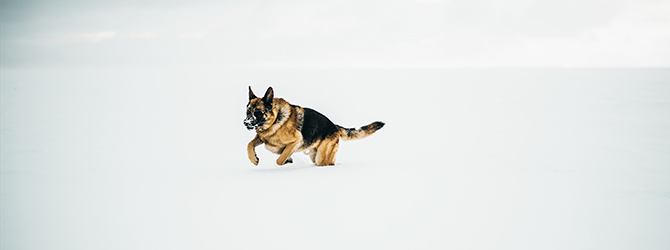Snow safety: 5 tips for walking your dog in the snow
There’s no doubt that walking through snow is a picturesque experience, but it’s not without its risks either, especially when you’re walking through it with an excitable dog! Let’s take a look at the amendments to make to your usual walking routine, in order to keep you and your pooch comfortable when walking in the snow.
Extra preparations
Before setting out on your dog-walk through the snow, double check you have everything you need. You know your dog better than anyone does – do they need a coat or jumper to keep them warm?
Are you wearing enough layers yourself? If you’ve done any de-icing out in the yard, or if you’ve used a product like antifreeze on your car, make sure any chemical substances are thoroughly washed away before letting your dog out.
Watch out for ice
You might do this anyway but once you’re out of the house, keep your dog on the lead until you get to an area that’s 100% grassy and 0% slippery/dangerous. Pavements are not nice things to fall over on to, so you want to keep your pooch as calm as possible until they get to softer turf.
Hard surfaces will be incredibly cold in snowy conditions too, which could hurt your dog’s feet, so you don’t want to be walking through streets any longer than necessary.
Don’t suffer, either of you
There’s no shame in shortening your dog’s walk a little bit when the weather is freezing. If your dog is a big burly Labrador, you’ll probably find that you’re ready to come home before they are. On the other hand, if you have a short-haired dog, such as a whippet, take into account that they’ll be feeling the cold more than you are, even in their coats.
Dry paws after a walk
No matter how keen you are to get back in front of the fire, don’t forget to wash your dog’s paws thoroughly after a walk in the snow – especially if they have long fur. Snow can compress between their toes, which is painful and can cause problems. Washing their paws also keeps the footpads in good condition and gives you the chance to check that no salt or grit from the roads have got stuck anywhere. It’s important to wash salt/grit away so your dog doesn’t lick it off themselves, which is very dangerous.
A warm refuge
Once you’re home, washed and dried, think about what your pet would appreciate most. (A biscuit probably, but you know…) A nice, warm, cosy and quiet bed or sleeping area will help them get back to normal quickly. It’s especially important during the winter months to ensure that your pet’s sleeping area (everywhere in your house, for that matter) stays dry and damp-free! If you spot damp or mould anywhere, try to fix it as soon as possible and do your utmost to keep your pet away from it.
Need more advice?
If you need more advice on caring for your pet during the winter, have a chat with your vet.
Find your nearest vet using our Find a Vet page, or speak to a vet online using Online Vets.

